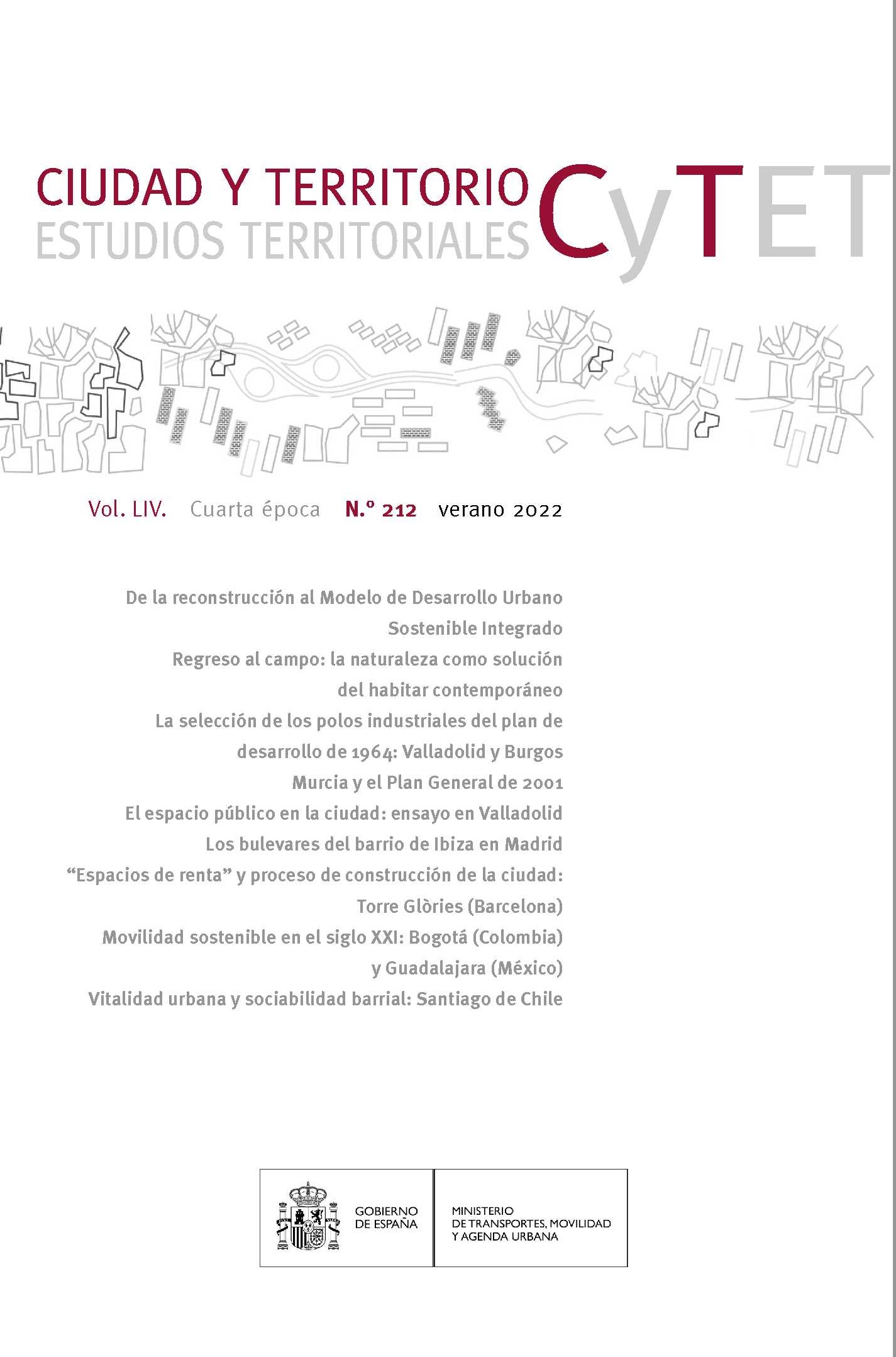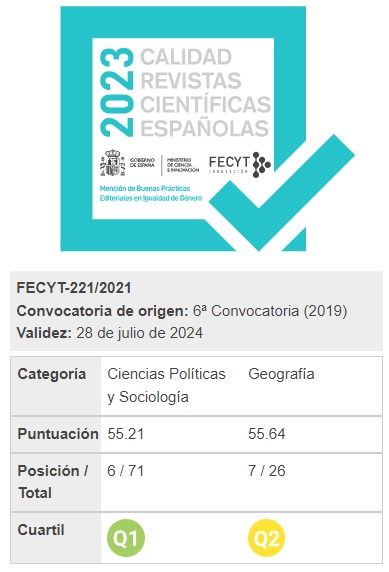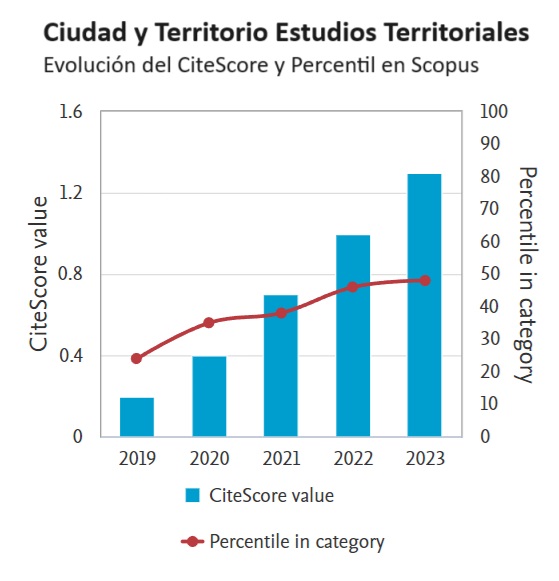Return to the countryside: nature as a solution for contemporary living
DOI:
https://doi.org/10.37230/CyTET.2022.212.2Keywords:
Anthropocene, Countryside, Living, Landscape, RuralAbstract
The city of the Anthropocene is torn between compactness and sprawl. The objective of the research seeks the keys to find a new ethic for the disciplines of architecture and urban planning in the city of the future. This ethic is understood from a perspective closer to the Mediterranean city of our environment, possibly less dense and more sustainable, conceived as the set of historical, cultural and natural values that make up the landscape, where cities and their architecture are figures that must keep the balance of a territory. The concept of the Mediterranean city would not simply be that of the compact city, rather the opposite. This ideal would be closer to that of a post-diffuse city. Beyond the simple dispersion, we found in the countryside, once again, the solution to the problems that the postmodern city has generated. The rural, until now a residual and despised space, becomes nowadays an essential value for living in the city itself.
Downloads
References
Barnett, J. & Blaesser, B.W. (2017): Reinventing development regulations, Cambridge, Massachusetts, USA, The Lincoln Institute of Land Policy
Benabent Fernández De Córdoba, M. (1998): Estudio territorial para la delimitación de ámbitos comarcales en Andalucía. Arenal Consultores, Sevilla (inédito)
Castro Escobar, E. & González González, M.& Múnevar Quintero, C. (2018): Paradigmas y tendencias en la organización del espacio rururbano: una revisión teórica. Ciudad y Territorio Estudios Territoriales, 50(196), 187-200.https://recyt.fecyt.es/index.php/CyTET/article/view/85833
Chinchilla, I (2020): La ciudad de los cuidados. Salud, economía y medio ambiente, Madrid, Ed. Catarata.
Crutzen, P. (2007): The Anthropocene: Are Humans Now Overwhelming the Great Forces of Nature?, AMBIO: A Journal of the Human Environment 38, n.º 8
Dominguez, M. (2020): La ciudad antes, durante y después del COVID-19, Universidad Pablo de Olavide, Centro de Sociología y Políticas Locales-The Urban Governance Lab Fundación Pública Andaluza., Junta de Andalucía, Sevilla, Centro de Estudios Andaluces, Consejería de la Presidencia, Administración Pública e Interior
Garcia Roman, M.D., (1976): Valor actual del modelo de Von Thüneny dos comprobaciones empíricas, en revista Geografía nº 10, pp11-33, https://www.raco.cat/index.php/RevistaGeografia/article/viewFile/45703/56694
Heidegger, M. (2015): Construir, habitar, pensar. (Bauenwohnendenken). Edición bilingüe de Arturo Leyte y Jesús Adrián. Madrid. La Oficina Ediciones
Ibañez, D. & al. (Ed) (2019): Wood Urbanism: From the Molecular to the Territorial, NYC, Actar Publishers.
Indovina, F. (Ed) (1990): La cita diffusa. Venecia. Italia, Daest.
Jacobs, J. (2013): Muerte y vida de las grandes ciudades, Madrid, Capitán Swing Libros, S.L
Jiménez Romera, C. (2015): Tamaño y densidad urbana. Análisis de la ocupación de suelo por las áreas urbanas españolas. Tesis Doctoral. Departamento de Urbanística y Ordenación del Territorio. Escuela Técnica Superior de Arquitectura. Universidad Politécnica de Madrid. Recurso electrónico en línea:http://habitat.aq.upm.es/tydu/atydu_1.html
López De Lucio, R. (1993): Ciudad y urbanismo a finales del siglo XX, Universidad de Valencia, Servicio de Publicaciones.
López De Lucio, R 2007): Construir ciudad en la periferia: criterios de diseño para áreas residenciales sostenibles. Madrid, Ed. Mairea
Mattei, U. (2017): Las Leyes de la Naturaleza y la naturaleza del Derecho. Derecho & Sociedad, (48), 163-171.http://revistas.pucp.edu.pe/index.php/derechoysociedad/article/view/18982
Ministerio De Fomento. (2018): Áreas urbanas en España 2018. Constitución, Cuarenta años de las ciudades española. Madrid. Secretaría General Técnica. Centro de publicaciones
Mumford, L. (2015): Historia natural de la urbanización. Chicago, Illinois, USA, The University Chicago Press. 1956.Publicación del Instituto Juan de Herrera. Escuela Técnica Superior de Arquitectura. Universidad Politécnica de Madrid.
Parra, F. (2007). La cultura del territorio: la naturaleza contra el campo. Ciudad y Territorio Estudios Territoriales, 39(151), 27-51. https://recyt.fecyt.es/index.php/CyTET/article/view/75753
Piñero, A. (Coord) (2015): El urbanismo de la no ciudad. Los procesos de ocupación irregular en el suelo no urbanizable de Andalucía. Sevilla, Universidad de Sevilla.
Reig, E. Goerlich, F & Cantarino, I. (2016): Delimitación de áreas rurales y urbanas a nivel local. Bilbao, Fundación BBVA.
Rueda, S. (2012): Libro Verde de la Sostenibilidad Urbana y Local en la era de la información. Red de redes de desarrollo local sostenible”. Madrid. Servicio de publicaciones del Ministerio Agricultura, Alimentación y Medio Ambiente.
Soja, E W. (2000): Postmetropolis: critical studies of cities and regions, Los Ángeles, USA, Blackwell Publishing,Terán, de F. (1970): La crisis del planeamiento: [editorial]. "Ciudad y Territorio" (n. 2) Madrid; pp. 4-5.
UN-HABITAT III (2016): Urbanization and development: emerging futures. UN-Habitat, World Cities Report.
Valladares, F. 6 Gil, P. & Forner, A. (coord.).(2017): Bases científico-técnicas para la Estrategia estatal de infraestructura verde y de la conectividad y restauración ecológicas. Ministerio de Agricultura y Pesca, Alimentación y Medio Ambiente. Madrid. 357 pp.
Verdaguer, C. (2013): El campo y la ciudad, áreas de reencuentro. Hacia una Nueva Cultura del Territorio, Hábitat y Sociedad, nº6, www.habitatysociedad.us.es
Zumthor, P. (2006): Pensar la arquitectura, Barcelona.Ed. GG
Published
How to Cite
Issue
Section
License
Copyright (c) 2022 Nicolás Moncada García

This work is licensed under a Creative Commons Attribution-NonCommercial-NoDerivatives 4.0 International License.
Considering the provisions of the current legislation on Intellectual Property, and in accordance with them, all authors publishing in CyTET give -in a non-exclusive way and without time limit- to the Ministry of Transport, Mobility and Urban Agenda the rights to disseminate, reproduce, communicate and distribute in any current or future format, on paper or electronic, the original or derived version of their work under a Creative Commons Attribution-NonCommercial-NoDerivative 4.0 license International (CC BY-NC-ND 4.0), as well as to include or assign to third parties the inclusion of its content in national and international indexes, repositories and databases, with reference and recognition in any case of its authorship.
In addition, when sending the work, the author(s) declares that it is an original work in which the sources that have been used are recognized, committing to respect the scientific evidence, to no longer modify the original data and to verify or refute its hypothesis. Author(s) also declare that the essential content of the work has not been previously published nor will it be published in any other publication while it is under evaluation by CyTET; and that it has not been simultaneously sent to another journal.
Authors must sign a Transfer of Rights Form, which will be sent to them from the CyTET Secretariat once the article is accepted for publication.
With the aim of promoting the dissemination of knowledge, CyTET joins the Open Journal Access (OA) movement and delivers all of its content to various national and international indexes, repositories and databases under this protocol; therefore, the submission of a work to be published in the journal presupposes the explicit acceptance by the author of this distribution method.
Authors are encouraged to reproduce and host their work published in CyTET in institutional repositories, web pages, etc. with the intention of contributing to the improvement of the transfer of knowledge and the citation of said works.








 Enlace a CyTET en Linkedin
Enlace a CyTET en Linkedin